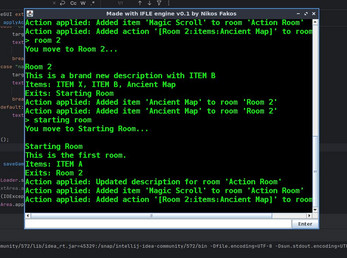IFLE engine
A downloadable engine for Windows, macOS, and Linux
Download NowName your own price
IFLE Engine v0.4
Welcome to the Interactive Fiction Engine (IFLE) v0.4! This little engine written by Nikos Fakos (astric-games.itch.io). The engine is designed to create and play text-based adventure games, where players can explore rooms, interact with items, and solve puzzles.
>>Including a debugging version to help you debug your games<<
1. Dependencies & Requirements
- Java Runtime Environment (JRE 8+)
Ensure Java is installed. Test with
java -versionin your terminal. Download from Oracle or use OpenJDK.
7. Running the Engine
- Run:
java -jar ifle_engineV03.jar
8. Example Scenario
Goal: Unlock a door using a key.
- rooms.txt:
Starting Room A room with a locked door. [Starting Room:exits:@East Room] Key north East Room A room with a chest. null Gold west
- Items.txt:
Key A shiny key. [Starting Room:exits:East ROom] The door unlocks!
- Gameplay:
- Player enters
get key. - Player enters
use key→ Unlocks the east exit. - Player enters
east room→ Moves to East Room.
Actions use the format:[Target:Field:NewValue]Supported Targets:- Rooms: Modify
description,items,exits,actions, orname. - Items: Modify
name,description,action, ortext when used.
- Change a room's description:
[Attic:description:You see a hidden passage!] - Add an exit to a room:
[Starting Room:exits:east] - Update an item's action:
[Key:action:[Treasure Door:exits:east]]
[[Attic:exits:up], [Attic:description:A ladder appears!]] - Player enters
6. Commands & Gameplay
Player Commands:
look: Re-display current room.[exit]: Move to a connected room.get [item]: Pick up an item.drop [item]: Drop an item.inventory: List inventory items.examine [item]: Show item details.use [item]: Trigger the item's action.save: Save progress.reset: Reset game to initial state.
Find out more on Builder's Manual.
| Status | Released |
| Platforms | Windows, macOS, Linux |
| Author | Astric Games |
| Genre | Interactive Fiction |
| Tags | Game engine, java, text-adventure, Text based |
| Average session | Days or more |
| Inputs | Keyboard |
| Accessibility | Configurable controls, Blind friendly |
Download
Download NowName your own price
Click download now to get access to the following files:
rooms.txt 363 bytes
rooms.bu 363 bytes
progress.txt 0 bytes
Items.txt 175 bytes
Items.bu 175 bytes
ifle_engineV04.jar 23 kB
ifle_debuggingV04.jar 24 kB
ifle_buildersManual_V04.pdf 79 kB
Development log
- IFLE engine v0.4 is up!Feb 19, 2025
- Version with new features about items and actions! [version 0.3]Feb 11, 2025
- IFLE engine updated to version 0.2! [Logical error fix]Feb 10, 2025


Leave a comment
Log in with itch.io to leave a comment.